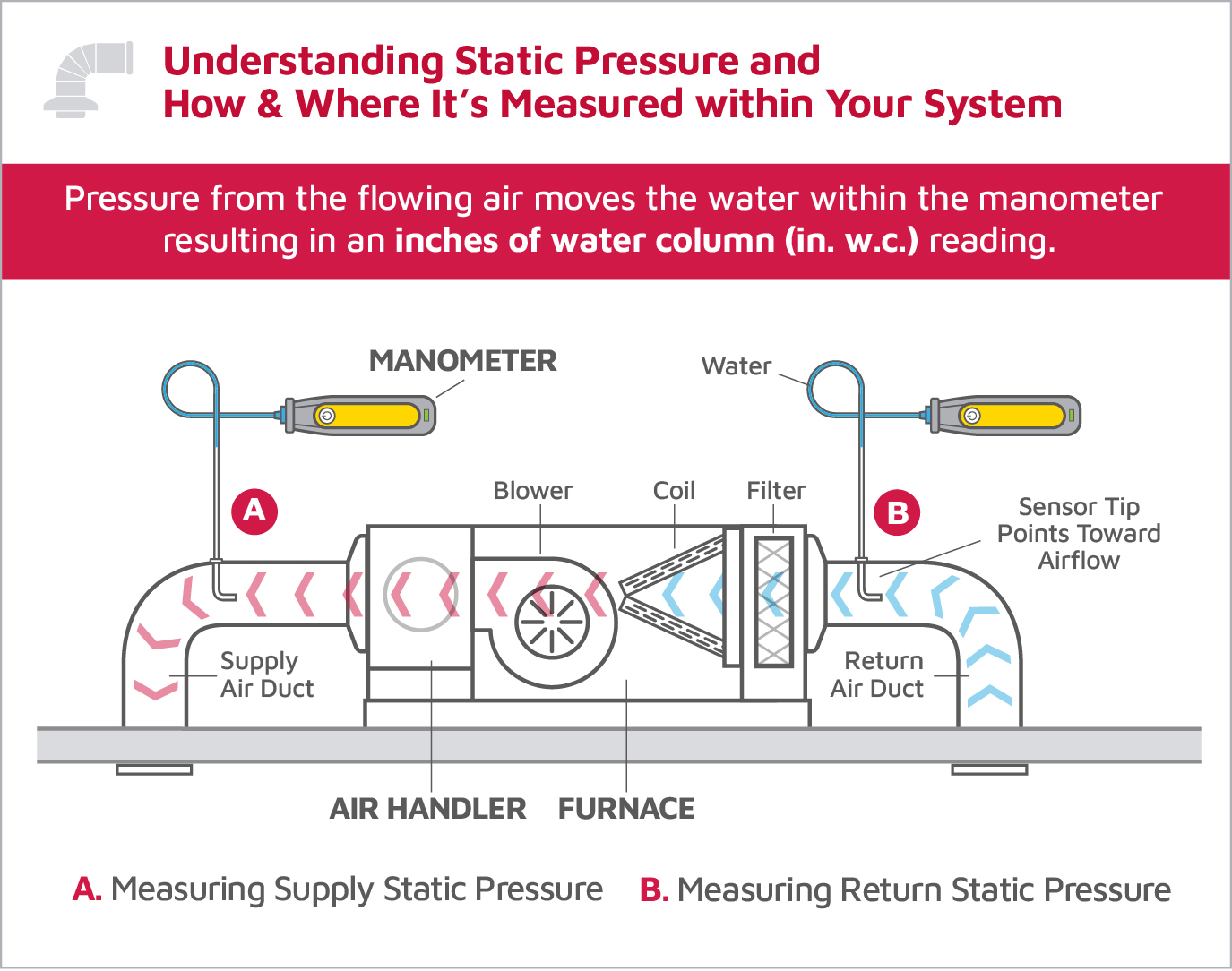When your HVAC system isn’t heating or cooling your home evenly, the culprit might not be your thermostat or even your equipment. It may be an airflow issue caused by improper static pressure.
Understanding what static pressure is, how it affects system performance, and what you can do to maintain it can help improve comfort consistency, energy efficiency, and the longevity of your system.
Understanding Static Pressure
In HVAC terms, static pressure refers to the resistance that air encounters as it moves through your home’s ductwork. Just as blood pressure measures how hard your heart has to work to move blood through your veins, static pressure measures how hard your HVAC system must work to move air through your ducts.
When static pressure is balanced, your system operates efficiently and maintains consistent airflow throughout your home. When it’s too high, airflow is disrupted, resulting in uneven temperatures, higher energy costs, and unnecessary wear on your equipment.
Static Pressure vs. Dynamic Pressure
Air moving through your ducts creates two types of pressure—static and dynamic.
Static pressure is the resistance of stationary air against the duct walls.
Dynamic pressure is the force of the moving air.

Together, these two measurements determine how efficiently your HVAC system distributes conditioned air.
Static pressure is typically measured in inches of water column (in. w.c.) using a tool called a manometer. Most residential systems are designed to operate between 0.5 and 0.8 in. w.c. Anything higher than that range can signal an airflow problem that needs professional attention.
Why Static Pressure Matters
Proper static pressure is critical to maintaining energy efficiency, comfort, and overall system performance. Even small imbalances can create ripple effects throughout your home and your HVAC system.
Balanced Airflow and Comfort
Your HVAC system relies on a balance between supply air (air pushed out of the vents) and return air (air pulled back into the system). If static pressure is too high, air struggles to move through the ducts, leading to weak airflow and rooms that never seem to reach the right temperature. If it’s too low, air moves too freely, which can prevent your system from delivering even heating and cooling.
When static pressure is properly balanced, air circulates evenly throughout the home, improving both comfort and indoor air quality.
Energy Efficiency and Equipment Protection
When airflow is restricted by high static pressure, your blower motor must work harder to push air through the ducts. This not only increases energy consumption but can also cause premature wear on the blower, coil, and compressor.
Low static pressure can be just as problematic, reducing heating or cooling output, and causing your system to run longer cycles to reach the thermostat setting. Both situations can lead to higher utility bills and decreased system lifespan.
Maintaining correct static pressure allows your HVAC equipment to operate efficiently, keeping your home comfortable while lowering energy costs.
Signs and Causes of Static Pressure Problems
Issues with static pressure often reveal themselves through subtle symptoms at first. Recognizing these signs early can help you avoid costly repairs.
Common signs of improper static pressure include:
- Minimal air coming from vents
- Uneven heating or cooling between rooms
- Loud or whistling noises from ductwork
- Higher-than-average energy bills
- Short-cycling (the system turning on and off frequently)
Common Causes
Several factors can contribute to static pressure issues:
- Clogged or dirty air filters: One of the most common causes of high static pressure. A blocked filter restricts airflow and forces the system to work harder.
- Closed or blocked vents: Furniture, curtains, or rugs covering vents can disrupt balanced airflow.
- Improperly sized ductwork: Ducts that are too small create resistance, while oversized ducts can reduce pressure too much.
- Dirty or restrictive coils: Dust buildup on coils restricts air movement and raises pressure inside the system.
- Duct leaks or poor installation: Air escaping through gaps or poorly sealed joints can unbalance the system.
Maintaining Proper Static Pressure
Homeowners can take several steps to help maintain healthy static pressure and support efficient HVAC performance.
- Replace Filters Regularly: Dirty filters are the leading cause of high static pressure. Clean filters are the first step toward keeping air flowing freely through your system. Replacement intervals can vary based on the type of filters you use and your system components. Check with your HVAC technician or dealer for specific replacement recommendations.
- Keep Vents Open and Clear: Ensure supply and return vents are unobstructed by furniture or drapes. Closing vents in unused rooms may seem efficient but can actually increase static pressure by disrupting airflow balance.
- Schedule Regular Maintenance: Professional maintenance is the most reliable way to monitor and manage static pressure. During an inspection, a certified HVAC technician will measure static pressure using specialized tools, check for duct obstructions or leaks, and ensure your blower motor and components are working efficiently.
- Upgrade Ductwork or Components: If your home’s ductwork is outdated or improperly sized, upgrading to a more efficient design can improve airflow and reduce resistance. A professional can also install variable-speed blowers or high-efficiency air filters that enhance performance without increasing pressure.
Proper static pressure is essential for your HVAC system to deliver reliable comfort and efficient performance. Balanced airflow keeps your home’s temperature consistent, lowers energy costs, and prevents unnecessary strain on your equipment.
If you’ve noticed uneven temperatures, weak airflow, or higher utility bills, your system’s static pressure may be the issue. Reach out to a local HVAC professional to schedule an evaluation and learn how optimizing airflow can improve both comfort and efficiency in your home.



